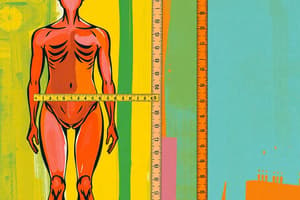Podcast
Questions and Answers
What does Waist to Hip Ratio (WHR) measure?
What does Waist to Hip Ratio (WHR) measure?
- Overall fat and muscle stores
- Muscle mass, subcutaneous fat, and bone
- Abdominal fatness
- Body fat distribution and adiposity (correct)
What does Mid-Upper Arm Circumference (MUAC) measure?
What does Mid-Upper Arm Circumference (MUAC) measure?
- Fat stores and arm size (correct)
- Abdominal fatness
- Body frame size
- Overall fat and muscle stores
What does Body Mass Index (BMI) estimate?
What does Body Mass Index (BMI) estimate?
- Muscle mass
- Abdominal fatness
- Degree of obesity (correct)
- Body frame size
What does Waist Circumference indicate?
What does Waist Circumference indicate?
What does Knee Height measurement determine?
What does Knee Height measurement determine?
What does Waist to Hip Ratio (WHR) measure?
What does Waist to Hip Ratio (WHR) measure?
What does Knee Height measurement determine?
What does Knee Height measurement determine?
What does Waist Circumference indicate?
What does Waist Circumference indicate?
What does Mid-Upper Arm Circumference (MUAC) measure?
What does Mid-Upper Arm Circumference (MUAC) measure?
What does Body Frame Size allow the weight to be adjusted for?
What does Body Frame Size allow the weight to be adjusted for?
Flashcards
What does Waist to Hip Ratio (WHR) measure?
What does Waist to Hip Ratio (WHR) measure?
A measure of body fat distribution and adiposity, calculated by dividing waist circumference by hip circumference.
What does Mid-Upper Arm Circumference (MUAC) measure?
What does Mid-Upper Arm Circumference (MUAC) measure?
An indicator of fat stores and arm size, measured by circling the upper arm halfway between the shoulder and the elbow.
What does Body Mass Index (BMI) estimate?
What does Body Mass Index (BMI) estimate?
An estimation of the degree of obesity, calculated by dividing weight in kilograms by height in meters squared.
What does Waist Circumference indicate?
What does Waist Circumference indicate?
Signup and view all the flashcards
What does Knee Height measurement determine?
What does Knee Height measurement determine?
Signup and view all the flashcards
What does Body Frame Size allow the weight to be adjusted for?
What does Body Frame Size allow the weight to be adjusted for?
Signup and view all the flashcards
What is Waist to Hip Ratio (WHR) used for?
What is Waist to Hip Ratio (WHR) used for?
Signup and view all the flashcards
What is Mid-Upper Arm Circumference (MUAC) used for?
What is Mid-Upper Arm Circumference (MUAC) used for?
Signup and view all the flashcards
What is Body Mass Index (BMI) used for?
What is Body Mass Index (BMI) used for?
Signup and view all the flashcards
What is Waist Circumference a key indicator of?
What is Waist Circumference a key indicator of?
Signup and view all the flashcards
Study Notes
Waist to Hip Ratio (WHR)
- Measures the ratio of a person's waist circumference to hip circumference.
- Reflects body fat distribution, specifically the amount of fat stored around the abdomen.
- A higher WHR is associated with an increased risk of chronic diseases, such as heart disease, type 2 diabetes, and some types of cancer.
Mid-Upper Arm Circumference (MUAC)
- Measures the circumference of the upper arm, specifically at the midpoint between the elbow and shoulder.
- Indicates the level of muscle mass and body fat, serving as a proxy for nutritional status.
- Used to assess malnutrition and overall health, especially in children and vulnerable populations.
Body Mass Index (BMI)
- Estimates body fat based on a person's height and weight.
- A measure of overall weight relative to height but does not distinguish between muscle mass and body fat.
- Classified into categories (underweight, normal weight, overweight, and obese) to assess overall nutritional status.
Waist Circumference
- Measures the circumference of the waist at the narrowest point, typically around the belly button.
- Indicates abdominal fat accumulation, even in individuals with a normal BMI.
- A larger waist circumference is associated with higher risks of developing chronic diseases.
Knee Height measurement
- Measures the length of the knee from the bottom of the heel to the top of the knee.
- Estimates total body height, useful when measuring someone who is unable to stand.
- Can be used to calculate frame size and body mass index (BMI).
Body Frame Size
- Allows the weight to be adjusted for a person's bone structure.
- Frame size is determined by measuring knee height, elbow width, and wrist circumference.
- It is used to account for individual variations in bone size and weight.
Studying That Suits You
Use AI to generate personalized quizzes and flashcards to suit your learning preferences.




